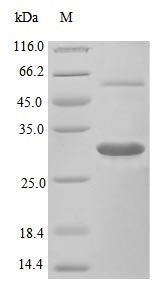Recombinant Mouse Macrophage colony-stimulating factor 1 protein (Csf1) comes from an E. coli expression system and covers amino acids 33-262 of the protein. This tag-free version shows purity levels above 95% when checked by SDS-PAGE analysis. The protein appears to be fully biologically active, demonstrating an ED50 of less than 2 ng/ml in murine M-NFS-60 cell proliferation assays. This translates to a specific activity greater than 5.0 × 10^5 IU/mg. Endotoxin levels stay below 1.0 EU/µg, as measured by the LAL method.
Macrophage colony-stimulating factor 1 (Csf1) seems to play a critical role in how mononuclear phagocytes are produced, differentiate, and function. The immune system likely depends on this protein for processes like macrophage activation and survival. Research in immunology, hematopoiesis, and cellular biology often turns to Csf1 as a key tool for understanding macrophage-related pathways and how cells interact with each other.
Potential Applications
Note: The applications listed below are based on what we know about this protein's biological functions, published research, and experience from experts in the field. However, we haven't fully tested all of these applications ourselves yet. We'd recommend running some preliminary tests first to make sure they work for your specific research goals.
1. Cell Proliferation and Viability Assays for Macrophage Research
This recombinant mouse Csf1 protein is confirmed to be biologically active (ED₅₀ < 2 ng/ml in murine M-NFS-60 cells) and can be used to stimulate macrophage proliferation and survival. However, since the protein is a partial sequence (33-262aa) and M-NFS-60 cells are typically used for G-CSF (Csf3) assays, researchers should validate its activity in more relevant macrophage-specific cell lines (e.g., RAW264.7 or bone marrow-derived macrophages) to ensure physiological relevance. The high specific activity (>5.0×10⁵ IU/mg) and low endotoxin levels support reliable dose-response studies, but results may not fully represent native Csf1 function due to the truncated form.
2. Biochemical Characterization and Receptor Binding Studies
The tag-free design and high purity (>95%) make this protein suitable for biochemical studies of Csf1-receptor interactions. However, the partial sequence may lack full receptor-binding domains present in the full-length protein, potentially affecting binding kinetics and affinity measurements. Researchers should interpret data from surface plasmon resonance or competitive binding assays with caution and validate key findings with full-length Csf1 when possible.
3. Antibody Development and Validation
This biologically active Csf1 can serve as an immunogen for antibody development, but the partial sequence may generate antibodies that do not recognize full-length Csf1. Antibodies should be validated against native, full-length Csf1 in biological samples to ensure recognition of all relevant epitopes. The high purity and defined sequence are advantageous for standardization, but functional neutralization assays may require confirmation with full-length protein.
4. Signal Transduction Pathway Analysis
The protein is appropriate for studying Csf1 signaling pathways due to its confirmed activity, but the E. coli expression system lacks mammalian post-translational modifications, which could alter signaling kinetics or amplitude. Researchers should verify that phosphorylation events (e.g., MAPK, PI3K pathways) mirror those induced by native Csf1, especially in primary cells.
5. Preclinical Model Development and Validation
This recombinant Csf1 can be used in preclinical models, but the partial sequence may not fully recapitulate native Csf1 function in complex systems. While low endotoxin levels and biological activity support reproducibility, researchers should validate key outcomes (e.g., macrophage differentiation) with full-length Csf1 to ensure translational relevance.
Final Recommendation & Action Plan
This E. coli-expressed partial mouse Csf1 protein (33-262aa) has validated biological activity and is suitable for initial studies, but its truncated nature requires careful validation for each application. Prioritize confirming activity in macrophage-specific cell lines beyond M-NFS-60 to ensure relevance. For binding and signaling studies, compare results with full-length Csf1 to account for potential domain deficiencies. When developing antibodies, test cross-reactivity with native protein. While the high purity and low endotoxin levels make it useful for controlled assays, critical findings should be verified with full-length Csf1 to ensure biological accuracy. Always include appropriate controls and dose-response curves to mitigate limitations associated with the partial sequence.






